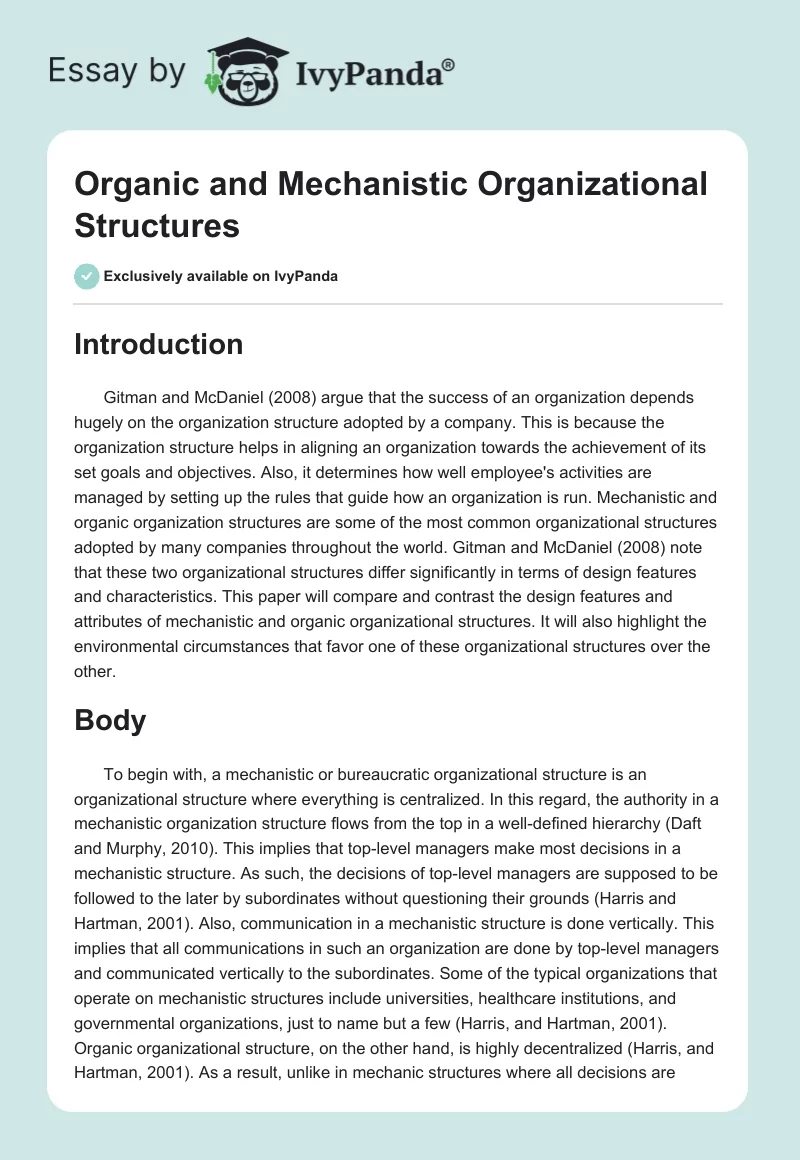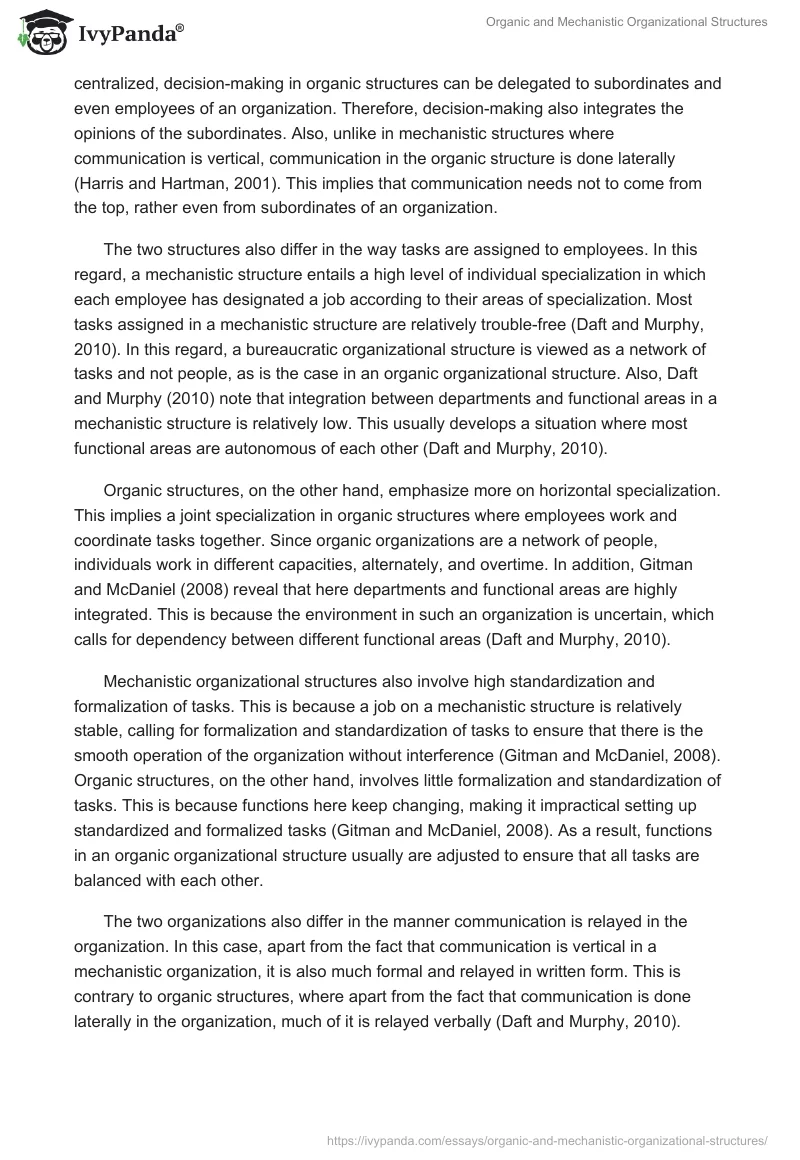Introduction
Gitman and McDaniel (2008) argue that the success of an organization depends hugely on the organizational structure adopted by a company. This is because the organizational structure helps align an organization toward achieving its goals and objectives. Also, it determines how well employee’s activities are managed by setting up the rules that guide how an organization is run.
Mechanistic and organic organization structures are some of the most common organizational structures many companies adopt worldwide. Gitman and McDaniel (2008) note that these two organizational structures differ significantly in terms of design features and characteristics. This paper will compare and contrast the design features and attributes of mechanistic and organic organizational structures. It will also highlight the environmental circumstances that favor one of these organizational structures over the other.
Body
To begin with, a mechanistic or bureaucratic organizational structure is an organizational structure where everything is centralized. In this regard, the authority in a mechanistic organization structure flows from the top in a well-defined hierarchy (Daft and Murphy, 2010). This implies that top-level managers make most decisions in a mechanistic structure. As such, the decisions of top-level managers are supposed to be followed to the later by subordinates without questioning their grounds (Harris and Hartman, 2001). Also, communication in a mechanistic structure is done vertically. This implies that all communications in such an organization are done by top-level managers and communicated vertically to the subordinates. Some of the typical organizations that operate on mechanistic structures include universities, healthcare institutions, and governmental organizations, just to name but a few (Harris, and Hartman, 2001). Organic organizational structure, on the other hand, is highly decentralized (Harris, and Hartman, 2001). As a result, unlike in mechanic structures where all decisions are centralized, decision-making in organic structures can be delegated to subordinates and even employees of an organization. Therefore, decision-making also integrates the opinions of the subordinates. Also, unlike in mechanistic structures where communication is vertical, communication in the organic structure is done laterally (Harris and Hartman, 2001). This implies that communication needs not to come from the top, rather even from subordinates of an organization.
The two structures also differ in the way tasks are assigned to employees. In this regard, a mechanistic structure entails a high level of individual specialization in which each employee has designated a job according to their areas of specialization. Most tasks assigned in a mechanistic structure are relatively trouble-free (Daft and Murphy, 2010). In this regard, a bureaucratic organizational structure is viewed as a network of tasks and not people, as is the case in an organic organizational structure. Also, Daft and Murphy (2010) note that integration between departments and functional areas in a mechanistic structure is relatively low. This usually develops a situation where most functional areas are autonomous of each other (Daft and Murphy, 2010).
Organic structures, on the other hand, emphasize more on horizontal specialization. This implies a joint specialization in organic structures where employees work and coordinate tasks together. Since organic organizations are a network of people, individuals work in different capacities, alternately, and overtime. In addition, Gitman and McDaniel (2008) reveal that here departments and functional areas are highly integrated. This is because the environment in such an organization is uncertain, which calls for dependency between different functional areas (Daft and Murphy, 2010).
Mechanistic organizational structures also involve high standardization and formalization of tasks. This is because a job on a mechanistic structure is relatively stable, calling for formalization and standardization of tasks to ensure that there is the smooth operation of the organization without interference (Gitman and McDaniel, 2008). Organic structures, on the other hand, involves little formalization and standardization of tasks. This is because functions here keep changing, making it impractical setting up standardized and formalized tasks (Gitman and McDaniel, 2008). As a result, functions in an organic organizational structure usually are adjusted to ensure that all tasks are balanced with each other.
The two organizations also differ in the manner communication is relayed in the organization. In this case, apart from the fact that communication is vertical in a mechanistic organization, it is also much formal and relayed in written form. This is contrary to organic structures, where apart from the fact that communication is done laterally in the organization, much of it is relayed verbally (Daft and Murphy, 2010).
Environmental circumstances that suit organic and mechanistic structures
The finding shows that the two organizational structures work perfectly in different environments. In this regard, the report indicates that a mechanistic organizational structure suits organizations that function in stable and specific environments (Gitman and McDaniel, 2008). Organic organizational structure, on the other hand, works best in an environment full of uncertainties and dynamism (Daft and Murphy, 2010). In this regard, it becomes apparent that the two organizational structures operate effectively in two distinct environments. This implies that since the mechanistic structure only works best in specific and stable environments, it cannot work in an environment full of uncertainties and dynamism, as is the case with organic structures.
References
Daft, D. R. L., & Murphy, J. (2010). Organizational theory and design. Manson, OH: Cengage Learning EMEA.
Gitman, L.J., & McDaniel, C.D. (2008). The future of business: the essentials. New York, NY: Cengage Learning.
Harris, O.J., & Hartman, S.J. (2001). Organizational behavior. Binghamton, NY: Routledge.


